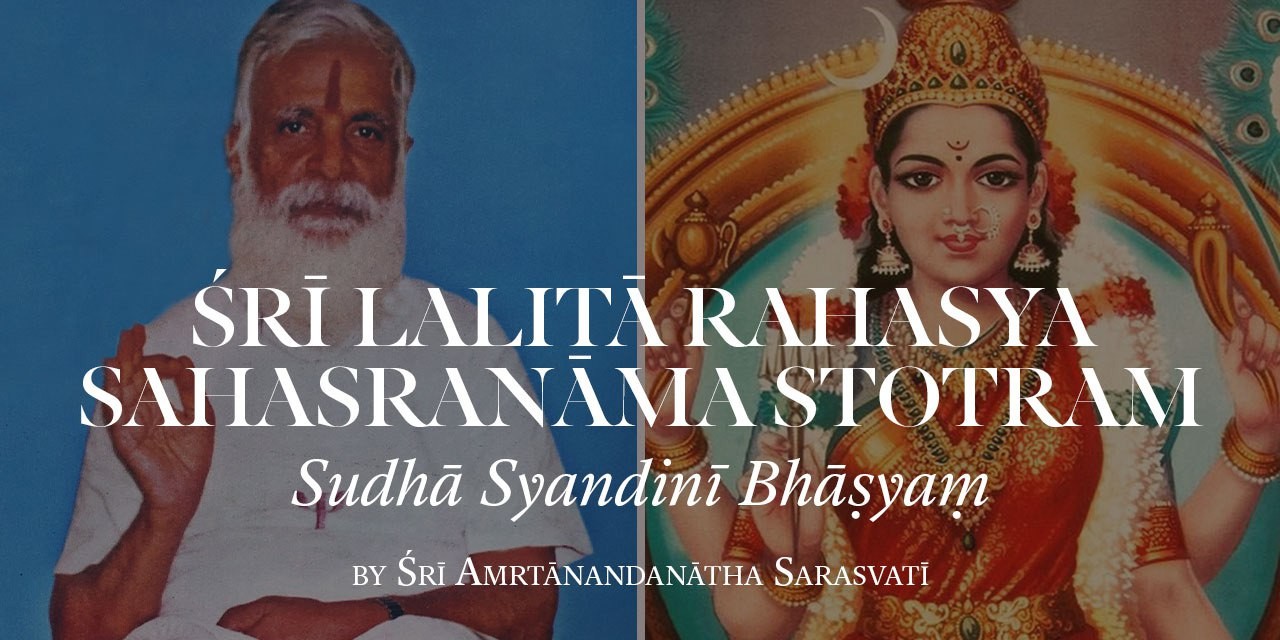
28) Mandasmita-prabhāpūra-majjatkāmeśa-mānasā
Śrī Devi is always smiling. And the heart of Kāmeśvara is drowning helplessly in the flood of light emanating from Her smile. Devi's smile is born as Mohinī from the sea of milk when gods and demons churned it with the meru using Mount Meru as the churning device and the primal power of Kuṇḍalinī represented by Vāsuki, the snake, for the rope. This Mohinī carried the cup of nectar, [representing] the Goddess Ratī Devi or Sudhā, and distributes it to the gods and cheats the demons from getting a taste of the immortal bliss of Ratī. In this puranic legend is the timeless story of man's travails in meditation.
The esoteric significance of this story will now be explained. The Meru, the Mandara Mountain is a tall mountain resembling a stick, the symbolism pointing clearly to the liṅga. The Kuṇḍalinī, Vāsuki, is the power of awareness going round and round the churning stick, the membrum virile. When this stick is churned in the sea of milk, the primal womb, the Kuṇḍalinī circulates as contact awareness. Since awareness is Lalitā, Her bliss expresses itself as a smile on the lips, which is Mohinī. The continued churning produces the blissful fluid of immortality, the seed, the kulāmṛtam. This seed then is distributed between gods and demons, Gods get the share of immortality and demons get the share of mortality.
What can this mean? Gods are those that do not entertain motions of duality. Demons are those that do. So, gods operate on the basis of love, while demons operate on the basis of lust. When passion is controlled, the seed is not ejaculated. If it is released physically, it can lead to the birth of a mortal being. If it is released mentally, many things are born of it. The jewels, the nectar of gods, Lakṣmī Herself; these relate to godly and immortal gifts.
The concept of brahmācāryam as:
retaining the seed, and
moving always in utmost bliss is most beautifully told in this story of the smile of Devi.
The śruti says: “Ānando brahmeti vyajānāt” – Know that utter bliss is Brahman. The highest pitch of bliss is obtained with immortality by controlling the desire to a level such that a continuous relaxation, a continuous orgasmic experience is possible instead of a momentary ejaculation followed by exhaustion.
Sādhana
When you are able to control lust, then you become Kāmeśa. Kāmeśa is the husband of Lalitā. When lust is replaced by love, Lalitā shows Her aesthetic and erotic forms to Her devotees; but remember, to reach this stage you must really have become Kāmeśa.
The upāsana of Lalitā is done through Kāmakalā on the three planes:
On the physical plane there are two devotees in sexual union, the coupling of the erect penis and the vulva being merely used to arouse the Kuṇḍalinī, the contact awareness.
On the mental plane, the sexual act is visualised and experienced to the rhythm of the Śrī Devi's mantra given by the Guru. Here the male member of the diad identifies himself with the Guru, and the female partner identifies herself with the Śakti.
On the causal plane, the mantra identifies itself with the Devi who assumes then Her own form which is indescribably beautiful, and the witness in each becomes Kāmeśa.
Thus is the sādhana, there is a sixfold identity – the male sādhaka, the Guru, the female sādhakī, Kuṇḍalinī Śakti, the mantra as Śrī Devi, and Kāmeśa, the self in all and the all in self.
See the following table:
Male Sadhaka | Female Sādhakī
Guru | Kuṇḍalinī Śakti
Kāmeśa, the witness | Śrī Devi, the Mantra
In such an upāsana of Kāmakalā, all egoistic notions are to be left behind, all dualities are to be left behind, all bondages are to be left behind, all lust is to be controlled. What happens then? The nāda, the sound of Anāhata merges the mantra into it, the form of Devi merges Anāhata into it, and finally the witness merges Devi into himself; all dualities are obliterated and one exclaims, I am God in all, all is in me. The bi-unity which is neither one nor many is experienced as the underlying truth behind all manifestations. Desires tend to drop off on their own accord. The fact that sex is used as a step towards spiritual evolution makes tantras the most suitable method for the Kaliyuga. Tantras are vedanta in practice. This Kāmakalā is also known as the upāsana of Nāda bindu kalā. The nāda results from the union of the devotees and the arousal of Kuṇḍalinī. The mind, and the seed, together called bindu, absorbs the nāda, and there is a temporary vacuum, a darkness, avyakta. Then the visions of Lalitā manifest, and that is the kalā, the superconscious bliss of supreme experience. Beyond these three states of nāda, bindu, kalā, the pure non-vaccuous experience of unconditioned existence, knowledge, bliss is known.
In the physical plane, Kuṇḍalinī is in the pair of cakras Mūlādhāra and Svādhiṣṭhāna;
In the cental or astral plane, Kuṇḍalinī is in the pair of cakras Maṇipūra and Anāhata;
In the causal plane, Kuṇḍalinī is in the pair of cakras Viśuddhi and Ājñā;
Beyond all these three planes, Kuṇḍalinī is mating with Sadāśiva in the thousand petalled lotus when the forms of Śrī Devi are being observed by the pure witness in yourself, the Kāmeśa, Her husband, the one and only, "Ekam eva advitīyaṁ brahma”.
Source: Śrī Amṛtānandanātha Saraswatī "Sudhā Syandinī Bhāṣyaṃ" Typed Manuscript
(an incomplete commentary on Lalitā Sahasranāma)
